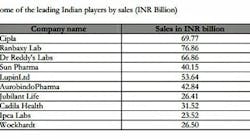The Indian pharmaceutical market is expected to reach $56 billion by 2020 according to forecasts and research by GlobalData. This is at a Compound Annual Growth Rate (CAGR) of 15 percent from $21 billion in 2013.
Driven by the rapid population growth and expanding middle class able to afford western medicine, these projections cement India's place as a leading international pharmaceutical market.
Pharmerging– [Pharm(aceutical) + (e)merging]–markets, led by the BRIC nations of Brazil, Russia, India and China, are all set to play a significant role in the growth of the pharmaceutical industry in the coming decade according to a CCI report. While India still trails China as the top Pharmerging market, many experts are optimistic for the future of pharmaceuticals in India.
"India is an emerging healthcare market that has remained unsaturated due to the limited penetration of healthcare insurance and poor access to healthcare facilities especially in rural areas. However, an increasing demand for high-quality services, affordability and a growing medical tourism industry will provide the necessary momentum for the growth of the pharmaceutical market," Joshua Owide, Director of Healthcare Industry Dynamics, said.
Top Indian Pharma Companies based on sales according to CCI's "A Brief Report on Pharmaceutical Industry in India"
There are setbacks to the expected growth in India, however. The lack of patent protection has proved undesirable to many multi-national pharma companies dominating the market, but has paved the way for India-based companies. While many of the top 10 pharma companies in India (see image) have products available across the globe, the Food and Drug Administration (FDA) has targeted many for patent violations.
"In order to increase transparency in the regulatory system, the Ministry of Health and Family Welfare is planning to introduce a bill into parliament in 2013, to create the Central Drug Authority (CDA), which will replace the current Central Drug Standard Control Organization. Once the CDA is formed, it will greatly improve the regulatory environment for pharmaceuticals, medical devices and clinical trials," Owide said.
Additionally, GlobalData records show that in 2012, 80.6 percent of the population was not covered by any form of health insurance, which may hinder expected growth.

